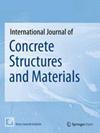Experimental Study of the Flexural Behaviour of RC Beams Made of Eco-friendly Sawdust Concrete and Strengthened by a Wooden Plate
IF 3.6
3区 工程技术
Q1 CONSTRUCTION & BUILDING TECHNOLOGY
International Journal of Concrete Structures and Materials
Pub Date : 2023-09-12
DOI:10.1186/s40069-023-00617-0
引用次数: 0
Abstract
Abstract In this paper, the effectiveness of the strengthening by a wooden plate for reinforced concrete (RC) beams that incorporate waste sawdust (SD) as a partial substitute for fine aggregate (sand) has been investigated. To this end, two types of concrete mixtures were made: normal concrete (NC) and sawdust concrete (SDC), which was made by substituting 15% of the volume of sand with SD. Five RC beams (100 mm in depth, 200 mm in width, and 1500 mm in length) were experimentally tested for flexural behavior under four-point loading. Three strengthening schemes were used in this study. The first scheme used a wooden plate that was only fixed by an adhesive layer. The second and third schemes were applied by a wooden plate, which was fixed by an adhesive layer and steel angles (two and eleven angles). The findings of the study indicate that although the concrete's workability, compressive, and splitting tensile strengths were reduced with the addition of SD, the ultimate load of the beam with SD was lower than that of the control beam, with a slight variation of approximately 4%. Moreover, strengthening the RC beam with a wooden plate and two steel angles yielded the highest load capacity among all tested beams, 20% higher than the control specimen. The study's findings offered useful information for developing eco-friendly sawdust concrete beams with efficient strengthening techniques for potential future uses.木屑环保混凝土配板加固RC梁抗弯性能试验研究
摘要本文研究了废木屑(SD)作为部分替代细骨料(砂)的钢筋混凝土(RC)梁的木板加固效果。为此,配制了两种类型的混凝土混合物:普通混凝土(NC)和锯末混凝土(SDC),锯末混凝土是用SD代替15%体积的沙子制成的。5根RC梁(深100毫米,宽200毫米,长1500毫米)在四点荷载下进行了抗弯性能试验。本研究采用了三种强化方案。第一个方案使用了一个只用粘合剂层固定的木板。第二种和第三种方案采用木板,通过胶粘剂层和钢角(2角和11角)固定。研究结果表明,虽然掺SD降低了混凝土的工作性、抗压强度和劈裂抗拉强度,但掺SD梁的极限荷载比对照梁的极限荷载低,变化幅度约为4%。在所有试验梁中,加板加角钢加固梁的承载力最高,比对照梁提高20%。这项研究的发现为开发具有有效加强技术的环保木屑混凝土梁提供了有用的信息,以供未来使用。
本文章由计算机程序翻译,如有差异,请以英文原文为准。
求助全文
约1分钟内获得全文
求助全文
来源期刊

International Journal of Concrete Structures and Materials
CONSTRUCTION & BUILDING TECHNOLOGY-ENGINEERING, CIVIL
CiteScore
6.30
自引率
5.90%
发文量
61
审稿时长
13 weeks
期刊介绍:
The International Journal of Concrete Structures and Materials (IJCSM) provides a forum targeted for engineers and scientists around the globe to present and discuss various topics related to concrete, concrete structures and other applied materials incorporating cement cementitious binder, and polymer or fiber in conjunction with concrete. These forums give participants an opportunity to contribute their knowledge for the advancement of society. Topics include, but are not limited to, research results on
Properties and performance of concrete and concrete structures
Advanced and improved experimental techniques
Latest modelling methods
Possible improvement and enhancement of concrete properties
Structural and microstructural characterization
Concrete applications
Fiber reinforced concrete technology
Concrete waste management.
 求助内容:
求助内容: 应助结果提醒方式:
应助结果提醒方式:


